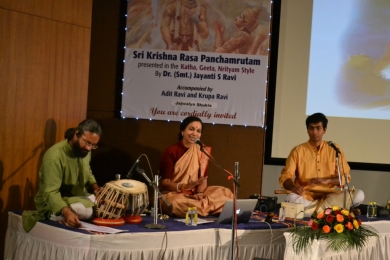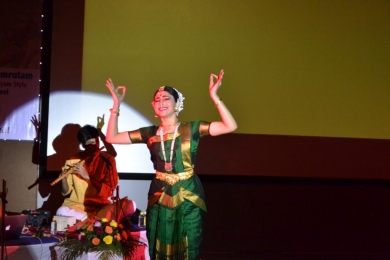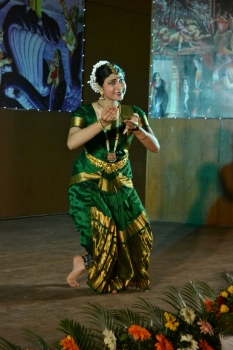
|   |

|   |
The microcosm of the universe within evoked - Dr. S D Desai e-mail: sureshmrudula@gmail.com December 25, 2014 ‘All that is harsh and dissonant in my life,’ Rabindranath sings, ‘melts into one sweet harmony.’ Dr. Jayanti Ravi’s ‘Shri Krishna Rasa Panchamrutam’ on December 21 at Ahmedabad in the ‘Katha, Geeta, Nrityam style’ created a rare anubhooti - that indescribable fine feeling within - with which, even within the four walls of the auditorium, momentarily a sensitive bhavaka feels being one with the element of ananda permeating the universe. In such moments, it is the microcosm of the universe within us that gets evoked, magically as it were, and makes us part of the universe free from dissonance as Tagore perceives. 

This presentation that does not fall into any known performance genre is distinctively different in many ways. It is guided with informed inputs culled from rich sources like the Bhagwad, the Geeta, the folklore, Shri Vallabhacharya, Meera, Swami Vivekananda and Shri Aurobindo, not to mention indigenous traditions like Yoga, Bhakti and Knowledge. The beauty of the presentation also lies in that whereas spirituality is commonly (mis)understood as something esoteric and unworldly, here, as a source of strength derived from the spirit humans are endowed with, it gets related to the duties we are called upon to perform in the mundane world. The binding thread is the Katha, a narrative of episodes in Shri Krishna’s life. With words carefully enunciated, Jayanti engagingly narrates them and gives the narrative a flow with her singing to the pleasing strains of her son Adit’s flute, accompanying the vocal recital and even independent and subdued rhythm on Jajwalya Shukla’s tabla. The evolving segments of the Panchamruta are Balakrishna, Lalakrishna, Gopala Krishna, Dwarkadheesh Krishna and Yogeshwar Krishna. Alongside clusters of enduring aural images emanating from a small platform on the right of the stage, where the vocalist and instrumentalists are seated, from the left wing from time to time emerges Krupa, a promisingly growing Bharatanatyam dancer, Jayanti’s daughter, with graceful visual images, quite lyrical in slow motion, translating the words and lines being heard. Spotlights enhance the impact both the vocalist and the dancer make. Yet another distinguishing feature forms part of the presentation. Three-part compact notes on each segment are in each listener’s hand, which along with the mantras and lines sung or referred to in the narrative, get flashed on a screen each on left and right of the stage. One part in a line or two interprets the relative episode. For example, the line tagged to Balakrishna is ‘Transformed or influenced lives of Yashoda, Nanda, whole of Gokulam, the nation, the world.’ (Probably, anachronism in the idea of nationhood.) Another is a quote from Swami Vivekananda, having interpretative relevance to the episode and in significance to society. The third part innovatively gives the listener space and time for reflection on self in relation to the surrounding.  Gopala Krishna has a playful samvad in a Tamil song between Yashoda and the adolescent Krishna keen to go out to graze cows, which Krupa suggests with dance movement and mudras. She won’t like him to go because it’s so hot out in the open. She tempts him with milk and butter. That doesn’t work. ‘There could be thieves and dacoits on the Yamuna bank.’ ‘Would I be afraid of them, mom!’ he retorts. ‘There would be wild beasts in the forest …’ ‘Oh, I’ve got the arrow, mom! And I love those deer there, you know!’ ‘What would I tell your dad when he comes?’ ‘Tell him I went to play ball with friends!’ The interpretation: Undaunted by perceived limited physical abilities, one can function from the ‘mind zone’ and beyond. And, ‘The less the thought of the body,’ Swami Vivekananda is quoted, ‘The better it is. For, it’s the body that drags us down.’ The point to ponder: ‘Do I limit my possibilities? … Can I function, drawing infinite strength from the Source?’ The presentation taking off with Gayatri Mantra and culminating in Madhurashtakam (floral and verbal felicitations following it illustrated what rasabhanga means!) has an appeal to the heart and the head and can be very well received in any part of the country. It combines in a form acceptable to the modern mind the tenets of bhakti, knowledge and karma ingrained in our culture. A small surprise that a busy person in administrative service is capable of it. The secret lies, I know, in the sanskaras received – and passed on. Dr. SD Desai, a professor of English, has been a Performing Arts Critic for many years. Among the dance journals he has contributed to are Narthaki, Sruti, Nartanam and Attendance. He guest-edited Attendance 2013 Special Issue. His books have been published by Gujarat Sahitya Academy, Oxford University Press and Rupa. After 30 years with a national English daily, he is now a freelance art writer. |